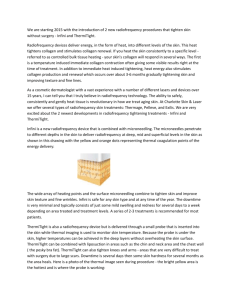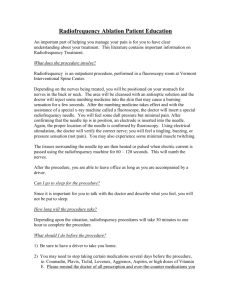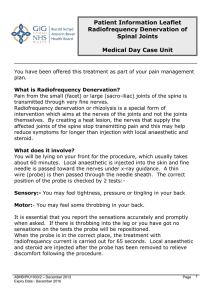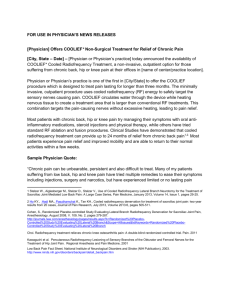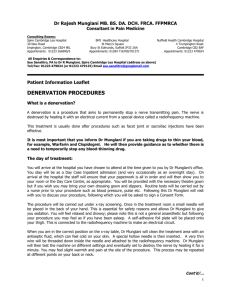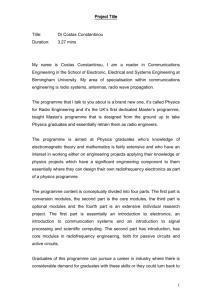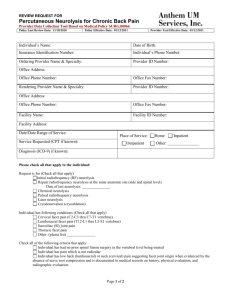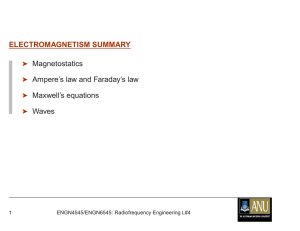Current Concepts of Neurolysis and Clinical Applications
advertisement
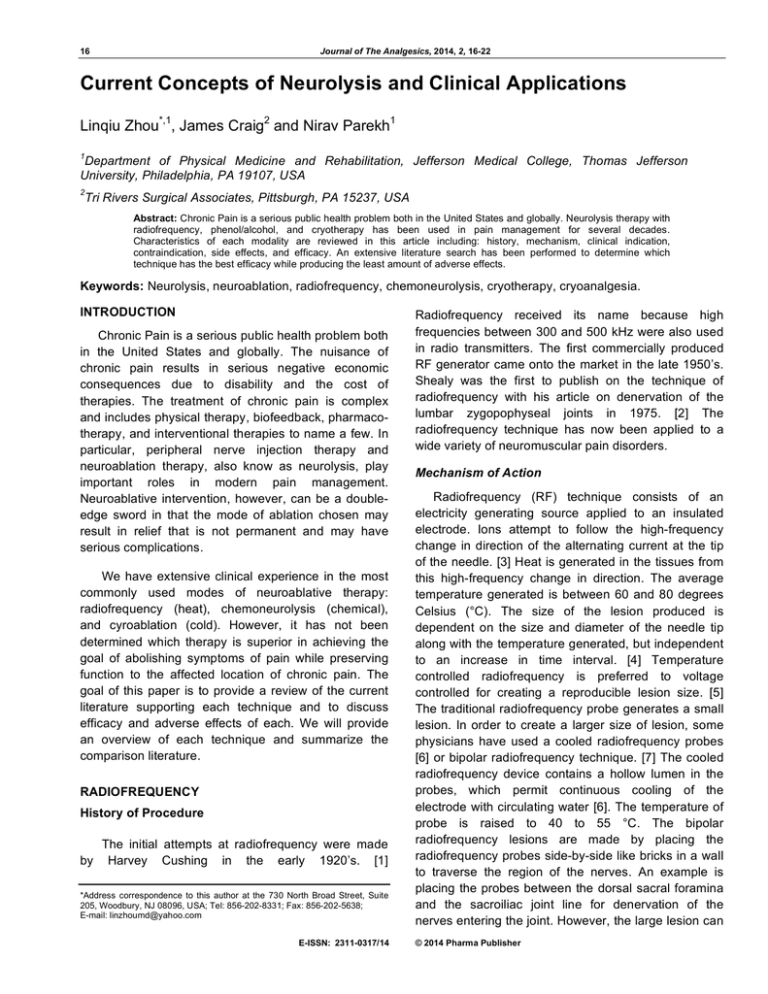
16 Journal of The Analgesics, 2014, 2, 16-22 Current Concepts of Neurolysis and Clinical Applications Linqiu Zhou*,1, James Craig2 and Nirav Parekh1 1 Department of Physical Medicine and Rehabilitation, Jefferson Medical College, Thomas Jefferson University, Philadelphia, PA 19107, USA 2 Tri Rivers Surgical Associates, Pittsburgh, PA 15237, USA Abstract: Chronic Pain is a serious public health problem both in the United States and globally. Neurolysis therapy with radiofrequency, phenol/alcohol, and cryotherapy has been used in pain management for several decades. Characteristics of each modality are reviewed in this article including: history, mechanism, clinical indication, contraindication, side effects, and efficacy. An extensive literature search has been performed to determine which technique has the best efficacy while producing the least amount of adverse effects. Keywords: Neurolysis, neuroablation, radiofrequency, chemoneurolysis, cryotherapy, cryoanalgesia. INTRODUCTION Chronic Pain is a serious public health problem both in the United States and globally. The nuisance of chronic pain results in serious negative economic consequences due to disability and the cost of therapies. The treatment of chronic pain is complex and includes physical therapy, biofeedback, pharmacotherapy, and interventional therapies to name a few. In particular, peripheral nerve injection therapy and neuroablation therapy, also know as neurolysis, play important roles in modern pain management. Neuroablative intervention, however, can be a doubleedge sword in that the mode of ablation chosen may result in relief that is not permanent and may have serious complications. We have extensive clinical experience in the most commonly used modes of neuroablative therapy: radiofrequency (heat), chemoneurolysis (chemical), and cyroablation (cold). However, it has not been determined which therapy is superior in achieving the goal of abolishing symptoms of pain while preserving function to the affected location of chronic pain. The goal of this paper is to provide a review of the current literature supporting each technique and to discuss efficacy and adverse effects of each. We will provide an overview of each technique and summarize the comparison literature. RADIOFREQUENCY History of Procedure by The initial attempts at radiofrequency were made Harvey Cushing in the early 1920’s. [1] *Address correspondence to this author at the 730 North Broad Street, Suite 205, Woodbury, NJ 08096, USA; Tel: 856-202-8331; Fax: 856-202-5638; E-mail: linzhoumd@yahoo.com E-ISSN: 2311-0317/14 Radiofrequency received its name because high frequencies between 300 and 500 kHz were also used in radio transmitters. The first commercially produced RF generator came onto the market in the late 1950’s. Shealy was the first to publish on the technique of radiofrequency with his article on denervation of the lumbar zygopophyseal joints in 1975. [2] The radiofrequency technique has now been applied to a wide variety of neuromuscular pain disorders. Mechanism of Action Radiofrequency (RF) technique consists of an electricity generating source applied to an insulated electrode. Ions attempt to follow the high-frequency change in direction of the alternating current at the tip of the needle. [3] Heat is generated in the tissues from this high-frequency change in direction. The average temperature generated is between 60 and 80 degrees Celsius (°C). The size of the lesion produced is dependent on the size and diameter of the needle tip along with the temperature generated, but independent to an increase in time interval. [4] Temperature controlled radiofrequency is preferred to voltage controlled for creating a reproducible lesion size. [5] The traditional radiofrequency probe generates a small lesion. In order to create a larger size of lesion, some physicians have used a cooled radiofrequency probes [6] or bipolar radiofrequency technique. [7] The cooled radiofrequency device contains a hollow lumen in the probes, which permit continuous cooling of the electrode with circulating water [6]. The temperature of probe is raised to 40 to 55 °C. The bipolar radiofrequency lesions are made by placing the radiofrequency probes side-by-side like bricks in a wall to traverse the region of the nerves. An example is placing the probes between the dorsal sacral foramina and the sacroiliac joint line for denervation of the nerves entering the joint. However, the large lesion can © 2014 Pharma Publisher Current Concepts of Neurolysis and Clinical Applications cause a standby lesion involving the adjacent tissue. [7] This can be avoided by precise localization of RF probe along the targeted nerve to produce excellent pain relief without causing standby lesions to the other surrounding tissues. Another technique of radiofrequency that has evolved is called pulsed radiofrequency. [8] This consists of using lower temperatures along with an active and inactive phase from the lesion generator. Pulsed radiofrequency is thought to cause less destruction to surrounding tissues. Podhajsky et al confirmed that lesions at traditional temperatures of 80° C caused injury consistent with tissue necrosis and Wallerian degeneration seven days after the procedure. [3] This traditional technique causes basal membrane damage and results in the incomplete regeneration, intraneural scarring and neuroma formation. Conversely, pulsed radiofrequency at 42° C caused transient changes including: endoneural edema, alterations in the blood-nerve barrier, and activation of fibroblasts. The nervous tissue, however, returned to normal conditions after approximately seven days. Clinical Indications Radiofrequency has been indicated and is being used in a variety of pain conditions. The following is a list of sites commonly targeted by radiofrequency: • Cervical, Thoracic, and Lumbar Zygopophyseal Joints (dorsal rami) • Dorsal Root Ganglia • Sacroiliac Joint • Indradiscal Electrothermal Therapy (IDET) • Cervicogenic Headaches • Sympathetically Mediated Pain • Trigeminal Neuralgia • Intercostal Neuralgia • Peripheral Neuroma Contraindications There are no specific contraindications for radiofrequency. General contraindications for all three of these procedures exist including: local infection, sepsis, coagulopathies, neuropathic pain at site of Journal of The Analgesics, 2014, Vol. 2, No. 2 17 injection, and major psychological disorders. This includes radiofrequency close to implanted medical devises and metal. Adverse Effects The usual adverse effects apply as for any procedures involving needling including: local bleeding, local infection, and damage to local structures. More specific to radiofrequency there have been reports of transient burning pain, transient numbness, and weakness. [9] Skin burns are a risk in the face of misused or faulty equipment. Post-denervation neuritis has also been reported in the literature and described as a sunburn-like feeling which usually resolves weeks after the procedure. Overall, complication rates of RF are generally low, ranging from 1 to 6.5%. [10-12] No long term complications were found in our literature review. Clinical Effectiveness Results of our literature review on radiofrequency produced a wide range of outcomes. The pain-free duration after RF was shown to be from six months to one year with good patient selection and accurate localization. [13, 14] The bulk of the literature is directed towards back mediated pain. Niemisto, et al performed a Cochrane Database review of radiofrequency for neck and back pain. [15] They found limited evidence that radiofrequency was effective for short-term relief of cervical pain. There was conflicting evidence from relief of pain from lumbar facet joint origin and limited evidence that IDET was not effective for discogenic low-back pain. There have been more recent studies since the review that have continued to show mixed results. Pevsner et al showed 77 of their 122 patients (63%) had good results 12 months after radiofrequency of the medial branches. [9] However, van Wijk et al demonstrated no difference in outcome between radiofrequency denervation of lumbar facet joints vs. a sham group in a randomized, double-blinded trial. [16] Visual analog pain scale scores improved for both groups demonstrating the placebo effect that goes along with most of these procedures. Additionally, a trial with radiofrequency on the dorsal root ganglia of the lumbosacral spine failed to show any advantage over a control group with local anesthetics. [17] A prospective study on repeat facet radiofrequency denervtion for low back pain by Zotti and Osti in 2010 showed significant sustained relief over a 12 month 18 Journal of The Analgesics, 2014, Vol. 2, No. 2 period. [18] Comparing the traditional RF to the Watercooled RF, there is no significant different outcome in the degree of pain relief and duration of pain relief in the treatment of sacroiliac joint pain. From this data we surmise that currently there is very limited evidence towards the effectiveness of radiofrequency therapy. Most studies are of a limited patient size and of a limited long-term follow-up. We conclude there is a need for further double-blinded, randomized trials to further elicit the efficacy of radiofrequency neurolysis therapy in the treatment of pain. Chemoneurolysis History of Procedure The development of chemical neurolytic agents started in the late 1800’s. In 1906, Levy and Baudouin were the first to inject neurolytic agents percutaneously. [18] In 1925, the first use of phenol was reported in neurolytic procedures. In this era, the goal was to treat pain in patients with short life expectancies such as cancer pain. Secondary to the side effects which will be discussed later, chemical neurolysis has fallen out of favor as a choice for lytic procedures. Mechanism of Action The common agents that are currently used include phenol, ethyl alcohol, and hypertonic saline. Phenol is a composed of carbolic acid, phenic acid, phenylic acid, phenyl hydroxide, hydroxybenzene, and oxybenzene. Phenol is mainly insoluble in water. It’s typically mixed with glycerol, radio-opague contrast, or water, which increases the concentration of phenol. Phenol mixed with water will cause more destruction to the tissues secondary to a wider amount of spread. An injection into tissues with phenol will cause nonselective destruction of nervous tissue. At concentrations less than 5%, phenol causes protein denaturation; concentrations greater then 5% cause protein coagulation, nonspecific segmental demyelization and Wallerian degeneration. [18] Commonly, a range of 5% to 10% concentration is used for chemical neurolysis. However, concentrations of 5% - 6% produce destruction of the nocioceptive fibers with minimal side effects. Phenol injections have an analgesic effect when first injected and are less painful then injections with ethyl alcohol. Ethyl Alcohol has a similar mechanism of action to Zhou et al. phenol. Alcohol produces a nonselective destruction of nervous tissue by precipitating cell membrane proteins, extracting lipid compounds, demyelination, and Wallerian degeneration. [18] Injections with alcohol will cause an initial burning along the nerve distribution, which is followed by numbness along the same distribution. The common concentration of ethyl alcohol used for chemoneurolysis ranges from 30% to 100% solution. Clinical Indications • Cancer Pain for patients with short life expectancy • Spasticity Management • Chronic Pain intractable to other modalities • Sympathetic mediated pain intractable to other modalities Contraindications A relative contraindication with the use of ethyl alcohol is to make sure patients are not taking medications which inhibit alcohol dehydrogenase. These medications including: metronidazole, oral hypoglycemic agents, beta-lactam antibiotics, etc. They inhibit alcohol dehydrogenase and patients can experience a disulfiram like reaction with injections of ethyl alcohol. Symptoms include flushing, vomiting, sweating, marked hypotension, and dizziness. Patients should be taken off these medications in a safe manner before these elective neurolytic blocks are performed. Adverse Effects The most common reason physicians shy away from chemical neurolysis is postneurolytic neuritis. The incidence has been reported as high as ten percent in some studies. The proposed theory is an incomplete destruction of somatic nerve and then painful regeneration of that nerve. Injections with these chemical neurolytic agents are difficult to control and thus unwanted spread to surrounding healthy tissues occurs. The patient may experience dysesthesias and hyperesthesia after the procedure. Often times the dysesthesias are worse than the patient’s original pain. Most cases will subside within a few months with conservative analgesics. However, a small population will have persistent dysesthesias and require more invasive techniques such as sympathectomy or rhizotomy. Other complications include cardiac rhythm Current Concepts of Neurolysis and Clinical Applications disturbances, hypotension, skin and non-target tissue necrosis, and CNS excitation. Also reported are temporary hypesthesia and anesthesia in a dermatomal distribution of the nerve roots. [18] This is rare and usually short lived. Paralysis is possible if the injected alcohol causes spasm of the artery of Adamkiewicz. [19] Again, as noted above, injections with alcohol have the potential to cause a disufiram like reaction if the patient is on an alcohol dehydrogenase inhibitor. Clinical Effectiveness The clinical literature on chemical neurolysis is very deficient of well-constructed studies. Most evidence is of anecdotal observations. In general, blocks using phenol tend to be less intense and of shorter duration than those using alcohol. In 2001, Furlan et al performed a literature review studying chemical neurolysis for the treatment of neuropathic pain. [20] They found that 44% of their patients reported meaningful pain relief. Nineteen percent reported no pain relief and 37% had no conclusion to therapy secondary to poor reporting in the studies. Cleary, this study demonstrates the mixed results with chemoneurolysis. An area where these techniques have seen some success is in the treatment of cancer related pain. Eisenberg et al in 1995 demonstrated a 91-94% success rate in relieving abdominal pain from pancreatic cancer with a celiac plexus block. [21] These blocks also appear to have short-term effects, with significant pain reduction for less than two months. Patients with short life expectancies who are not expected to survive past the duration of the pain relief are the best candidates. For the purposes of this paper, we did not investigate the literature on chemical neurolysis for the treatment of spasticity. Journal of The Analgesics, 2014, Vol. 2, No. 2 Mechanism of Action The cryoprobe consists of a hollow tube with a smaller inner tube. Expansion of gas or liquid enclosed in the cryoprobe results in the Joule-Thompson or Kelvin effects; that is, the high pressure coolant escapes through a small orifice in the inner tube which ultimately expands and cools. The temperatures of the cryoprobe are dependent on the characteristics of coolants (NO or CO2), pressure of coolant, and whether gas or liquid is enclosed. The temperatures of the cryoneedle tip range from -20° C to -196° C. This forms an ice ball at the tip of the catheter. The cold temperature creates neurological dysfunction that ranges from temporary conduction block to Wallerian degeneration. Effectiveness of the therapy is dependent on: proximity of the probe to the nerve, size of the probe, size of the ice ball formed, rate and duration of freezing, and temperature of the tissues in proximity to the probe. [22] The decrease in temperature disrupts the nerve structure and creates Wallerian degeneration in which there is an initial “dying back” of the proximal axon and myelin sheath. There is then subsequent degeneration of the distal axon and myelin. Surrounding Schwann cells proliferate to form a tubular structure for axon sprouting and regeneration of the nerve. The severities of cryolesion are dependent on the cryotemperatures: [23, 24] • First Degree or Neuropraxia: this is associated with minimal damage and disruption of neural function for around 2-3 weeks when the temperature of cryolesion is above -20° C. • Second Degree or Axonotmesis: this involves destruction of the axon and myelin sheath. This occurs at temperatures of form -60° C to -100° C and is the goal of cryoablation therapy. This level of pathology creates axonal damage, but leaves intact the endoneurium, perinerium, and epineurium. Therefore, nerve regeneration has a structured environment for re-growth and prevents neuroma formation that is common with other forms of neurolysis. • Third Degree to Fifth Degree or Neuromeis: when the temperatures are below - 140° C, the cryolesion involves destruction of both neural tissues. However, the epineurium and basal membrane remain intact. Our previous study demonstrated that there was minimal inflammation and no neurolitis or neuroma formation. [23, 24] Cryoanalgesia History of Procedure Cyroablation has been used for thousands of years. The modern cryoanalgesia started in 1961 after Cooper developed a hollow tube filled with liquid nitrogen. [22] Amoil developed a hand held device achieving a temperature of -70° C. Lloyd, et al. coined the term cryoanalgesia for its use in pain management. [22] Since then, cyroanalgesia has been used for treatment of lower back pain, neck pain, neuromas, trigeminal neuralgia, and intercostals neuralgia. 19 20 Journal of The Analgesics, 2014, Vol. 2, No. 2 This degree of damage is associated with longer duration of analgesia. Clinical Indications Cryoablation therapy is indicated for a variety of chronic pain syndromes. Indications include: • Spinal dorsal ramus mediated lower back pain [25, 26] and neck pain [27] • Chest wall pain (post-thoracotomy pain) [28] • Trigeminal Neuralgia • Painful Neuromas • Peripheral Neuropathies • Trigger Points • Coccydynia Contraindications There are no absolute contraindications to cryoanalgesia. Relative contraindications include bleeding diathesis and infection. [22] Bleeding issues are especially important in regions where it could go unnoticed such as the pelvis and thorax regions. Needles should never be placed through an infected region with any of the neurolytic procedures for fear of creating a deeper infection. In addition, caution should be used in patients with conditions that leave them vulnerable to cold such as Raynaud’s Disease, cryopathies (cryoglobulinemia, paroxysmal cold hemoplobinuria), and peripheral vascular disease. Adverse Effects Adverse effects including post cryoablation neuritis are very rare with cryoanalgesia. More common adverse effects include frostbite to skin, alopecia, depigmentation of skin, and damage to surrounding structures. These damages are usually very mild. The damage to surrounding structures most often occurs when the probe is moved before the probe is thawed. The Teflon coated cryoneedle, meticulous skin precautions, and careful technique can minimize these injuries. There is no neuritis (aggravating pain) after the procedure. Zhou et al. literature. The most widely studied area has been with the application of cryoanalgesia with post-thoracotomy pain. In 1980, Katz et al compared cryoanalgesia against local bupivacaine blocks in patients undergoing a thoracotomy. [28] They found a mean pain score of 1.8 (cryo patients) vs. 6.0 (bupivaccaine patients) postop day #1 from the procedure. Muller, et al found that intercostal nerves with cryoneurolysis at -60° C did not provide pain relief in all of their patients. [29]Bucerius, et al stated that cryoneurolysis of intercostal nerves with -80° C significantly decreased post-operative pain compared to bupivaccaine intercostal nerve block. [30] Pastor et al in 1996 reported in a double-blinded prospective study that cryoanalgesia was superior to pharmacological management of post-thoracotomy pain. [31] However, in a more recent study it was concluded that epidural anesthesia led to better pain relief and pulmonary function after thoracotomy compared to cryoanalgesia. [32] These studies demonstrate generally good results with cryotherapy for post-thoracotomy pain. Studies on cryotherapy for pain syndromes other than post-thoracotomy pain have also yielded mixed results. Clinically, outcomes to cryotherapy appear to be dependent on the temperature of the probe. Barnard, et al. using cryoneurolysis at -60° C, reported that 67% of his 43 patients were pain-free at a median of 90 days. [33] Zakrzewska, et al. reported that 84% of their 39 patients cryolesioned at -120° C experienced pain relief for one year. [34] Shao, et al. reported that 87% of their 1,997 patients experienced immediate pain relief with cryotherapy at -100° C to -180° C applied to the spinal dorsal ramus for low back pain. [25] Of these patients, 409 who experienced immediate pain relief were followed for an average of 2.5 years. They reported that 386 (94.3%) continued to achieve complete pain relief and were able to return to their original occupations. [25] To date, 6000 patients with acute and chronic low back pain have been treated with percutaneous cryoanalgesia. [26] There were no reports of neuroma or neuritis as a side effect. Five to twelve (average 8) year followed-up of 680 patients with questionnaires reveals a 93% satisfaction rate. There continues to be no literature comparing clinical outcomes of cryoanalgesia with different probe temperatures. Clinical Effectiveness RELEVANT LITERATURE NEUROLYTIC TECHNIQUES COMPARING As with the two previous techniques discussed, cyroablation therapy has had mixed results in the We performed an extensive literature search looking for comparison articles of the three neurolytic Current Concepts of Neurolysis and Clinical Applications techniques discussed above. In 2001, Mailis-Gagnon, et al performed a Cochrane Database review of radiofrequency ablation vs. chemical ablation in the treatment of sympathetically mediated pain. [35] They found four studies which met their inclusion criteria of which only one was a randomized study. There wasn’t enough evidence to show if either technique was superior or even effective individually for sympathectomy. The only difference they alluded to was the increased incidence of post-sympathectomy neuralgia with the chemolytic therapies. The other study of interest was a randomized trial comparing peripheral blocks of cryoablation vs. phenol in the management of chronic pain. [36] Significantly more patients in the phenol group received 20% or greater pain relief at 1, 12, and 24 weeks after the procedure. However, only 27% of the patients in the study received significant pain relief demonstrating poor effectiveness overall. Wang performed a randomized double-blind trial to compare the outcome of cryotherapy, chemoneurolysis, and lidocaine injection to spinal dorsal rami for low back pain. [37] In his study, 60 patients were randomized into three groups for cryotherapy, alcohol neurolysis and lidocaine injection respectively. In the 7 days after procedure, there was no difference in these three groups. However, in 1, 3, and 6 months, there were significant differences of pain relief between the cryotherapy group, alcohol neurolysis group, and lidocaine injection group. In direct comparison of the cryotherapy and alcohol groups, 65% (13/20) of the cryotherapy group compared to only 45% (9/20) of the alcohol group achieved complete pain relief. In spite of the above studies, we conclude that there is no literature that currently demonstrates which neurolytic modality can provide better and longer pain relief. Although there is some evidence that cryoanalgesia may cause less complications of neuritis, no head to head comparisons of adverse effects have been studied. We see a need for continued randomized, double-blinded studies to establish the overall effectiveness of these treatments and to compare their outcomes against one another. Journal of The Analgesics, 2014, Vol. 2, No. 2 [3] Podhajsky RJ, Sekiguchi Y, Kikuchi S, Myers RR. The Histologic Effects of Pulsed and Continuous Radiofrequency Lesions at 42°C to Rat Dorsal Root Ganglion and Sciatic Nerve. Spine. 2005; 30(9): 1008-1013. http://dx.doi.org/10.1097/01.brs.0000161005.31398.58 [4] Vinas FC, Zamorano L, Dujovny M, et al. In vivo and in vitro study of the lesions produced with a computerized radiofrequency system. Stereotact Funct Neurosurg. 1992; 58(1-4): 121-133. http://dx.doi.org/10.1159/000098985 [5] Buijs EJ, van Wijk RM, Geurts JW, et al. Radiofrequency lumbar facet devervation: a comparative study of the reproducibility of lesion size after 2 current radiofrequency techniques. Regional Anesthesia & Pain Medicine. 2004; 29(5): 400-407. [6] Watanabe I, Masaki R, Min N, et al. Cooled-tip ablation results in increased radiofrequency power delivery and lesion size in the canine heart: importance of catheter-tip temperature monitoring for prevention of popping and impedance rise. J Interv Card Electrophysiol. 2002; 6(1): 916. http://dx.doi.org/10.1023/A: 1014140104777 [7] Cosman EJ, Gonzalez C. Bipolar radiofrequency lesion geometry: Implications for palisade treatment of sacroiliac joint pain. Pain Practice. 2011; 11: 3-22. http://dx.doi.org/10.1111/j.1533-2500.2010.00400.x [8] Hata J, Perret_Karimi D, DeSelva C, et al. Pulsed radiofrequency current in the treatment of pain. Critical Review in Physical and Rehabilitation Medicine. 2011; 23 (14); 213-240. http://dx.doi.org/10.1615/CritRevPhysRehabilMed.v23.i14.150 [9] Pevsner Y, Shabat S, Catz A, Folman Y, Gepstein R. The role of radiofrequency in the treatment of mechanical back pain of spinal origin. European Spine Journal. 2003; 12(6): 602-605. http://dx.doi.org/10.1007/s00586-003-0605-0 [10] Karmick CA, Kramarich SS, Sitzman BT, et al. Complication rate associated with facet joint radiofrequency denervation procedures. Pain Med 2002; 3(2): 175-176. http://dx.doi.org/10.1046/j.1526-4637.2002.20249.x [11] Kornic CA, Kramarich SS, Sitzman B. Complications of lumbar facet radiofrequency denervation. Spine 2004; 29(12): 1352-4. http://dx.doi.org/10.1097/01.BRS.0000128263.67291.A0 [12] Herz DA, Parsons KC, Pearl L. Percutaneous radiofrequency foraminal rhizotomies. Spine 1983; 8(7): 729-32. http://dx.doi.org/10.1097/00007632-198310000-00008 [13] Schofferman J, Kine G. Effectiveness of repeated radiofrequency neurotomy for lumbar facet pain. Spine 2004; 29(21): 2471-3. http://dx.doi.org/10.1097/01.brs.0000143170.47345.44 [14] Dreyfuss P, Halbrook B, Pauza K, et al. Efficacy and validity of radiofrequency neurotomy for chronic lumbar zygapophysial joint pain. Spine 2000; 25(10): 1270-1277. http://dx.doi.org/10.1097/00007632-200005150-00012 [15] Niemisto L, Kalso E, Malmivaara A, et al. Radiofrequency denervation for neck and back pain. The Cochrane Database of Systematic Reviews. 2006; 1: 1-38. [16] van Wijk RM, Geurts JW, Wynne HJ, et al. Radiofrequency denervation of lumbar facet joints in the treatment of chronic low back pain: a randomized, double-blind, sham lesioncontrolled trial. Clinical Journal of Pain. 2005; 21(4): 335-344. http://dx.doi.org/10.1097/01.ajp.0000120792.69705.c9 [17] Jos WM, Geurts MD, Roelof MAW, et al. Radiofrequency lesioning of dorsal root ganglia for chronic lumbosacral radicular pain: a randomized, double-blind, controlled trial. The Lancet. 2003; 361: 21-26. http://dx.doi.org/10.1016/S0140-6736(03)12115-0 REFERENCES [1] [2] Raj PP, Ruiz-Lopez R. Textbook of Regional Anesthesia. Philadelphia, PA: Churchill Livingstone; 2002: 619-645. Shealy CN. Facet denervation in the management of back and sciatic pain. Clin Orthop Relat R. 1975; 115: 157-164. 21 22 Journal of The Analgesics, 2014, Vol. 2, No. 2 Zhou et al. [18] Raj PP, Anderson SR. Eds. Textbook of Regional Anesthesia. Philadelphia, PA: Churchill Livingstone 2002; 229-237. [19] Jain S, Gupta R. Neurolytic agents in clinical practice. 2nd ed. Philadelphia, PA: WB Saunders 2001; 220-225. [20] Furlan A, Lui P, Mailis A. Chemical Sympathectomy for Neuropathic Pain: Does it Work? Case Report and Systematic Literature Review. Clinical Journal of Pain. 2001; 17(4): 327-336. http://dx.doi.org/10.1097/00002508-200112000-00007 [21] Eisenberg E, Carr DB, Chalmers TC. Neurolytic celiac plexus block for treatment of cancer pain: A meta-analysis. Anesthia and Analgesia. 1995; 80(2): 290-295. [22] Trescot AM. Cryoanalgesia in Interventional Management. Pain Physician. 2003; 6: 345-360. [23] Zhou L, Kambin P, Casey K, et al. Mechanism research of cryoanalgesia. Neurol Res 1995; 17: 307-311. [24] Zhou L, Shao Z, Ou S. Electrophysiology for cryoanalgesia. Cryobiology 2003; 46(1): 26-32. http://dx.doi.org/10.1016/S0011-2240(02)00160-8 Surg 1989; 48: 15-18. http://dx.doi.org/10.1016/0003-4975(89)90169-0 [30] Bucerius J, Metz T, Walther T, et al. Pain is significantly reduced by cryoablation therapy in patients with lateral minithoracotomy. Ann Thorac Surg 2000; 70: 1100-1104. http://dx.doi.org/10.1016/S0003-4975(00)01766-5 [31] Pastor J, Morales P, Cases E, et al. Evaluation of intercostals cryoanalgesia versus conventional analgesia in postthoracotomy pain. Respiration. 1996; 63(4): 241-245. http://dx.doi.org/10.1159/000196553 [32] Brichon PY, Pison C, Chaffanjon P, et al. Comparison of epidural analgesia and cryoanalgesia in thoracic surgery. European Journal of Cardiothoracic Surgery. 1994; 8(9): 482-486. http://dx.doi.org/10.1016/1010-7940(94)90019-1 [33] Barnard D, Lloyd J, Evans J. Cryoanalgesia in the management of chronic facial pain. J Maxillofac Surg 1981; 9: 101-2. http://dx.doi.org/10.1016/S0301-0503(81)80024-0 [34] Zakrzewska JW, Nally FF, Flint SR. Cryotherapy in the management of paroxysmal trigeminal neuralgia: four-year follow-up of 39 patients. J Maxillofac Surg 1986; 14: 5-7. http://dx.doi.org/10.1016/S0301-0503(86)80248-X Pain [25] Shao Z, Zhou L, Shu XQ, et al. Cryotherapy in treatment of low back pain. Chin J Surg (Chinese) 1991; 29(12): 721-723. [26] Chen Z, Shao Z, Jin A, et al. Spinal dorsal ramus syndrome: An important etiology of nonspecific low back pain. Chin J Orthop (Chinese) 1999; 19(3): 139-141. [35] Mailis-Gagnon A, Furlan A. Sympathectomy for neuropathic pain. The Cochrane Database of Systematic Reviews. 2006; 1: 1-25. [27] Zhou L, Shao Z, Shu XQ, et al. Cryoanalgesia for cervicoscapulalgia. J Cervicolumbago (Chinese) 1994; 15(2): 85-86. [36] [28] Katz J, Nelson W, Forest R, Bruce D. Cryoanalgesia for Post-Thoracotomy Pain. The Lancet. 1980; 1(8167): 512513. http://dx.doi.org/10.1016/S0140-6736(80)92766-X Ramamurthy S, Walsh NE, Schoenfeld LS, Hoffman J. Evaluation of neurolytic blocks using phenol and cryogenic block in the management of chronic pain. Journal of Pain & Symptom Management. 1989; 4(2): 72-75. http://dx.doi.org/10.1016/0885-3924(89)90026-2 [37] Wang P, Liu YQ, Song X, et al. The comparison study with cryotherapy of spinal dorsal ramus lower back pain. Chin J Pain Med 2005; 11(2): 68-70. [29] Muller LC, Salzer GM, Ransmayr G, et al. Intraoperative cryoanalgesia for postthoracotomy pain relief. Ann Thorac Received on 19-11-2014 Accepted on 26-11-2014 Published on 30-01-2015 DOI: http://dx.doi.org/10.14205/2311-0317.2014.02.02.1 © 2014 Zhou et al.; Licensee Pharma Publisher. This is an open access article licensed under the terms of the Creative Commons Attribution Non-Commercial License (http://creativecommons.org/licenses/by-nc/3.0/) which permits unrestricted, non-commercial use, distribution and reproduction in any medium, provided the work is properly cited.
